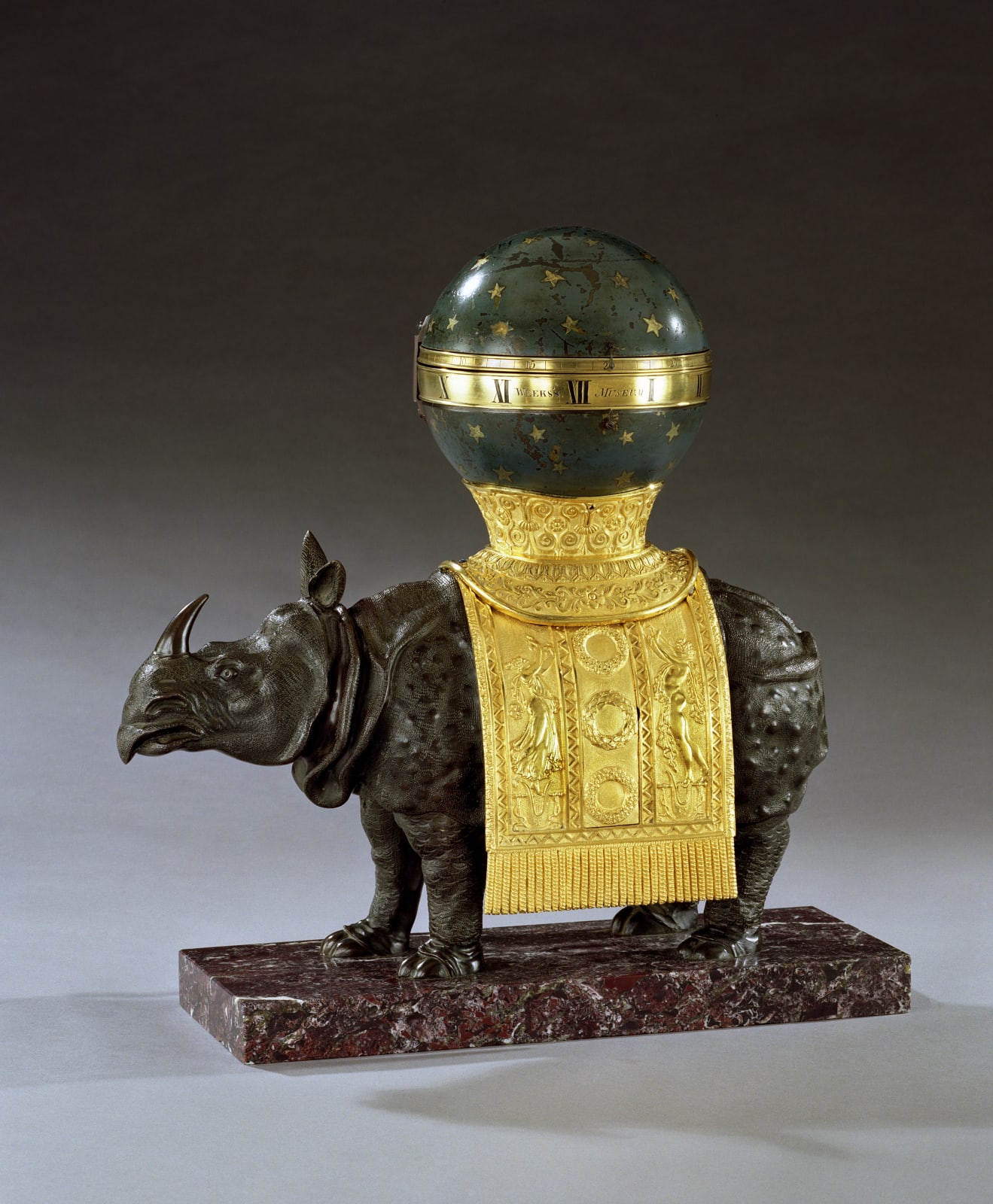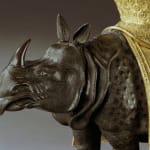A GEORGE III RHINOCEROS CLOCK BY THOMAS WEEKS , English, circa 1800
Width: 15 ¾ in; 39.5 cm
Depth: 6 ¼ in; 16 cm
An extraordinary early 19th century bronze and ormolu mounted clock in the form of a standing rhinoceros by Thomas Weeks, the clock movement formed as a celestial sphere with gilt stars against a midnight blue painted ground, the central twin horizontal rotating annular brass chapter rings for the hours and minutes, the minute ring engraved with Arabic five minute markers whilst the hour ring is engraved with Roman chapters and is signed WEEKS’S MUSEUM, the hour ring further engraved on the internal crossings 'Sold by Weeks’s Rl. Mechanical Museum Coventry Street Tichbourne St. London', the movement, housed within the belly of the beast, with twin spring barrels, one for the going train with anchor escapement and pendulum, the other spring barrel for striking on a single bell; the dust plate dividing the movement and motion work is further engraved ‘This Snaps in & out To take the Movement out…,’ the horological sphere cradled in a gilded howdah decorated with floral arabesques, the sides hung with tasselled hangings decorated with Pan and a nymph in low relief either side of three garlands, the body of the patinated bronze rhinoceros finely chased and naturalistically modelled, on a rectangular marble plinth base.
The appearance of a show rhinoceros in Paris in 1749, named Cara, caused a sensation as few had been seen in Europe and the arrival of this natural curiosity caught the imagination of the public. The beast had been brought to Rotterdam in 1741 by a Dutch sea captain and for 17 years toured Europe to great acclaim arriving briefly in England in 1751 and later in 1758 where she ended her days in Lambeth having already attracted flocks of visitors including the Royal family.
The earliest version of a mantel clock with a rhinoceros base dates to before 1747, when the inventory drawn up upon the death of the ‘maitre-fondeur’ Jean-Joseph de Saint-Germain's wife mentions ‘deux pendules au rhinoceros l'une pour modle et l'autre finie prises ensembles la somme de 140 livre’. There was a great fashion in the mid 18th century for clocks depicting exotic animals and the rhinoceros remains one of the rarest.
It was later in 1799 that another rhinoceros arrived in England and was exhibited by a Mr Piddick who kept a menagerie in Exeter. It is this animal that may have inspired the making of this clock. Amongst those who continued the tradition of the rhinoceros clock was the entrepreneur and museum owner Thomas Weeks (c.1743-1834), who was best known for his display of curiosities and inventions at his shop and ‘museum’, . Opened in the late 18th century the ‘Weeks Museum of Mechanical Curiosities’ off the Haymarket charged an entrance fee to a fascinated public where he displayed contraptions and automata and where this clock would have been displayed in a grand blue velvet hung rooms. Weeks’ finances often could not keep pace with his enthusiasm for invention resulting in a precarious fortune. With an eye for the fantastic he made this clock and perpetuated the legend of the animal depicting it in the French tradition as a majestic beast with a cloth of gold cascading down its sides as it supports a celestial globe timepiece. The museum continued until 1834 when the contents was dispersed at sale, Such wit, fantasy and humour make this a unique as well as an amusing timepiece of great rarity.
Provenance
‘The Weeks Museum’, London, until not after 1834;
The Codrington Family, Dodington Park, Gloucestershire.




